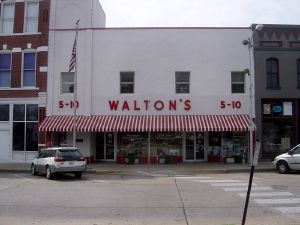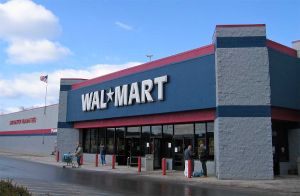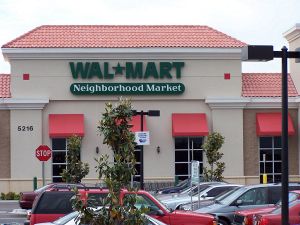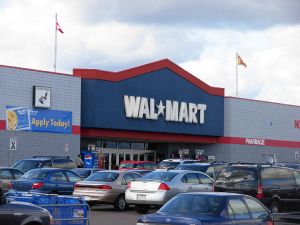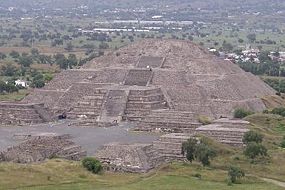Wal-Mart
| Wal-Mart Stores, Inc. | |

| |
| Type | Public (NYSE:Â WMT) |
|---|---|
| Founded | 1962 |
| Founder | Sam Walton |
| Headquarters | Bentonville, Arkansas |
| Key people | H. Lee Scott (CEO & President) S. Robson Walton (Chairman) |
| Area served | Worldwide |
| Industry | Retail |
| Products | Discount Stores Supercenters Neighborhood Markets |
| Revenue | |
| Operating income | |
| Net income | |
| Employees | aprox 2,100,000 (2008)[2]
|
| Website | www.walmartstores.com
|
Wal-Mart Stores, Inc. (or Walmart as written in its new logo) is an American public corporation that runs a chain of large, discount department stores. It is the world's largest public corporation by revenue, according to the 2008 Fortune Global 500.[3] Founded by Sam Walton in 1962, it was incorporated on October 31, 1969, and listed on the New York Stock Exchange in 1972. It is the largest private employer in the world and the fourth largest utility or commercial employer, trailing the British National Health Service, and the Indian Railways. Wal-Mart is the largest grocery retailer in the United States, with an estimated 20 percent of the retail grocery and consumables business. It also owns and operates the North American company, Sam's Club.
It operates in Mexico as Walmex, in the UK as ASDA, and in Japan as Seiyu. It has wholly-owned operations in Argentina, Brazil, Canada, and Puerto Rico. Wal-Mart's investments outside North America have had mixed results: its operations in South America and China are highly successful, while it was forced to pull out of Germany and South Korea when ventures there were unsuccessful. By 2008, Wal-Mart was operating 7,390 stores and club locations in 14 markets, employing more than 2 million people, and serving more than 176 million customers a year.[4]
Wal-Mart was one of the first companies to initiate a computer network that allowed suppliers to access their own inventory and sales figures. The centralized communication system has also allowed management to evaluate which products and services were most popular and cost-effective, and what sales techniques brought the best results, and then apply this knowledge to all Wal-Mart stores.
Wal-Mart has been criticized by some community groups, women's rights groups, grassroots organizations, and labor unions, specifically for its extensive foreign product sourcing, low rates of employee health insurance enrollment, resistance to union representation, and alleged sexism. Wal-Mart's operations are so extensive that it has become a political and economic power in its own right. It is the primary customer for many manufacturers, able to dictate their delivery schedules, inventory levels and even product specifications. In 2004, more than 70 percent of the goods sold in Wal-Mart, worth about US$18 billion, were manufactured in China. If it had been an individual economy, the company would have ranked as China's eighth largest trading partner, ahead of Russia, Australia, and Canada.[5]
History
Origins
Sam Walton (March 29, 1918 - April 5, 1992), the founder of Wal-Mart, began his retail career on June 3, 1940, at a J.C. Penney store in Des Moines, Iowa, three days after graduating from the University of Missouri with a degree in economics. After serving the in the military during World War II, with a loan from his father-in-law he purchased a franchise in Newport, Arkansas from Butler Brothers, a regional retailer that owned a chain of variety stores called Ben Franklin Stores.[6]In Newport Walton pioneered many concepts that helped to make his later businesses successful. He visited his competitorsâ stores to compare pricing and see how merchandise was displayed. Walton made sure his shelves were consistently stocked with a wide range of goods at low prices, and kept his store open later than most other businesses, especially during the Christmas season. He also developed the practice of discount merchandising by buying wholesale goods from the lowest-priced supplier. He drove up his sales volume by passing these savings on to his customers. The higher sales volumes allowed him to negotiate even lower prices with wholesalers on subsequent purchases. The store was in a central location, making it accessible to a wide range of customers. Walton's store was the leader in sales and profits in the Butler Brothers' six-state region. [7]
The store in Newport was so successful that when the lease expired, the landlord refused to renew it, wishing to acquire the business for his own son. Walton wanted to purchase a department store in St. Louis, but his wife insisted on living in a small town. Unable to find another location in Newport, Walton opened a new Ben Franklin franchise in Bentonville, Arkansas, but called it "Walton's Five and Dime." There he achieved higher sales volume by marking up his prices slightly less than most of his competitors.[8]
With the help of his brother, father-in-law, and brother-in-law, Walton opened more Ben Franklin stores. In 1954, he opened a store with his brother in a shopping center in Ruskin Heights, a suburb of Kansas City. He opened another, less successful store, in Arkansas. Walton decided to concentrate on retail business instead of the shopping centers and opened larger stores which were called "Walton's Family Center." Walton offered managers the opportunity to become limited partners if they would invest in the store they oversaw and then invest a maximum of $1,000 in new outlets as they opened. This motivated the managers to maximize profits and improve their managerial skills. By 1962, Walton and his brother Bud owned 16 variety stores in Arkansas, Missouri, and Kansas (15 Ben Franklin stores and the one independent Fayetteville store).
On July 2, 1962, Walton opened the first Wal-Mart Discount City store located in Rogers, Arkansas. Within five years, the company expanded to 24 stores across Arkansas and reached $12.6 million in sales.[9] In 1968, it opened its first stores outside Arkansas, in Sikeston, Missouri and Claremore, Oklahoma.
Incorporation and growth
The company was incorporated as Wal-Mart Stores, Inc. on October 31, 1969. In 1970, it opened its home office and first distribution center in Bentonville, Arkansas. It had 38 stores operating with 1,500 employees and sales of $44.2 million. It began trading stock as a publicly-held company on October 1, 1972, and was soon listed on the New York Stock Exchange. The first stock split occurred in May 1971 at a market price of $47. By this time, Wal-Mart was operating in five states: Arkansas, Kansas, Louisiana, Missouri, and Oklahoma; it entered Tennessee in 1973 and Kentucky and Mississippi in 1974. As it moved into Texas in 1975, there were 125 stores with 7,500 employees and total sales of $340.3 million.
During the 1980s, Wal-Mart continued to grow rapidly, and by its 25th anniversary in 1987 there were 1,198 stores with sales of $15.9 billion and 200,000 employees. In 1983, Walton founded Sam's Wholesale Club, a chain of deep-discount wholesale warehouse outlets. In 1987 the company completed its satellite network, a $24 million investment linking all operating units of the company with its Bentonville office via two-way voice and data transmission and one-way video communication. At that time, it was the largest private satellite network, allowing the corporate office to track inventory and sales and to instantly communicate to stores.[10]
In 1988, Sam Walton stepped down as CEO and was replaced by David Glass.[11] Walton remained as Chairman of the Board, and the company also rearranged other people in senior positions.
In 1988, the first Wal-Mart Supercenter opened in Washington, Missouri.[12] These superstores allowed Wal-Mart to surpass Toys "R" Us in toy sales in the late 1990s.[13] By 1991, Wal-Mart had surpassed Sears, Roebuck and Company to become the largest retailer in the United States. The company also opened overseas stores, entering South America in 1995 with stores in Argentina and Brazil; and Europe in 1999 when it bought ASDA in the UK for US$10 billion.[14]
In 1998, Wal-Mart introduced the "Neighborhood Market" concept with three stores in Arkansas. By 2005, estimates indicate that the company, in addition to being the worldâs largest retailer, controlled about 20% of the retail grocery and consumables business.[15]
In 2000, H. Lee Scott became President and CEO, and Wal-Mart's sales increased to $165 billion. In 2002, it was listed for the first time as America's largest corporation on the Fortune 500 list, with revenues of $219.8 billion and profits of $6.7 billion. It has remained there every year, except for 2006.[16]
In 2005, Wal-Mart had $312.4 billion in sales, more than 6,200 facilities around the worldâincluding 3,800 stores in the United States and 2,800 elsewhere, and more than 1.6 million employees worldwide. Its U.S. presence grew so rapidly that only small pockets of the country remained further than 60 miles (100 km) from the nearest Wal-Mart.[17] By 2008, Wal-Mart was operating 7,390 stores and Sam's Club locations in 14 markets, employing more than 2 million people, and serving more than 176 million customers a year.[18]
Recent initiatives
Environmental
In October 2005, Wal-Mart announced it would implement several environmental measures to increase energy efficiency. The primary goals included spending $500 million a year to increase fuel efficiency in Wal-Martâs truck fleet by 25 percent over three years and double it within ten, reduce greenhouse gas emissions by 20 percent in seven years, reduce energy use at stores by 30 percent, and cut solid waste from U.S. stores and Samâs Clubs by 25 percent in three years. CEO Lee Scott said that Wal-Mart's goal was to be a "good steward for the environment" and ultimately use only renewable energy sources and produce zero waste.[19] The company also designed three new experimental stores in McKinney, Texas, Aurora, Colorado, and Las Vegas, Nevada. With wind turbines, photovoltaic solar panels, biofuel-capable boilers, water-cooled refrigerators, and xeriscape gardens.[20]
Despite criticism of its environmental record, Wal-Mart took a few steps in what is viewed as a positive direction, which included becoming the biggest seller of organic milk and the biggest buyer of organic cotton in the world, as well as reducing packaging and energy costs. Wal-Mart also spent nearly a year working with outside consultants to quantify the company's total environmental impact and identify improvements that could be made. Wal-Mart learned, for example, that by eliminating excess packaging on its Kid Connection toy line, it could save not only $2.4 million a year in shipping costs but also 3,800 trees and a million barrels of oil.[21]
Commercial
Wal-Mart has also recently created its own electric company in Texas, Texas Retail Energy, to supply its stores with cheap power purchased at wholesale prices. Through this new venture, the company expects to save $15 million annually and to lay the groundwork and infrastructure to sell electricity to Texas consumers in the future.[22]
In March 2006, Wal-Mart sought to appeal to a more affluent demographic by launching a new Supercenter concept in Plano, Texas, intended to compete against stores with a more upscale image, such as Target.[23] The new store had wood floors, wider aisles, a sushi bar, a coffee and sandwich shop with free Wi-Fi Internet access, and more expensive beers, wines, electronics, and other goods. The exterior had a hunter green background behind the Wal-Mart letters, similar to Wal-Mart Neighborhood Markets, instead of the blue previously used at its supercenters.
In September, 2006, the company Wal-Mart phased out its layaway program, citing declining use and increased costs, and concentrated on other payment options, such as increased use of six- and twelve-month, zero-interest financing. Wal-Mart's Site-To-Store program, introduced in March 2007, enables walmart.com customers to buy goods online with a free shipping option, and have goods shipped to the nearest store for pickup.[24]
On September 12, 2007, Wal-Mart introduced new advertising with the slogan, "Save Money Live Better," replacing the "Always Low Prices, Always" slogan, which it had used for the previous 19 years. To support the ads, Global Insight conducted research that found that Wal-Mart's price level reduction had resulted in savings for consumers of $287 billion in 2006, which equated to $957 per person or $2,500 per household (up 7.3 percent from the 2004 savings estimate of $2,329).[25]
On June 30, 2008, Wal-Mart unveiled a new company logo, featuring the non-hyphenated name "Walmart" followed by a stylized spark, as it is referred to on store advertisements. The new logo received mixed reviews; some design critics question whether the new logo is as bold as competitors such as the Target bullseye or as instantly recognizable as the former company logo, which was used for 18 years.[26] The new logo made its debut on the company's walmart.com website on July 1, 2008, and will eventually replace store logos at the company's US locations. [27] Wal-Mart has not yet adopted the new logo internationally.
Subsidiaries
Wal-Mart's operations primarily comprise three retailing subsidiaries: Wal-Mart Stores Division U.S., Sam's Club, and Wal-Mart International. The company does business in nine different retail formats: supercenters, food and drugs, general merchandise stores, bodegas (small markets), cash and carry stores, membership warehouse clubs, apparel stores, soft discount stores and restaurants.[28].
Wal-Mart Stores Division U.S.
Wal-Mart Stores Division U.S. is Wal-Mart's largest business subsidiary, accounting for 67.2 percent of net sales for financial year 2006. It consists of three retail formats that have become commonplace in the United States: Discount Stores, Supercenters, and Neighborhood Markets. The retail department stores sell a variety of mostly non-grocery products, though emphasis has now shifted towards supercenters, which include grocery items. This division also includes Wal-Mart's online retailer, walmart.com.
Wal-Mart Discount Stores
Wal-Mart Discount Stores are discount department stores with size varying from 51,000 square feet (4,738.1 m²) to 224,000 square feet (20,810.3 m²), with an average store covering about 102,000 square feet (9,476.1 m²).[29]. They carry general merchandise and a selection of food. Many of these stores also have a garden center, a pharmacy, Tire & Lube Express, optical center, one-hour photo processing lab, portrait studio, a bank branch, a cell phone store and a fast food outlet. Some also have gasoline stations.][30]
In 1990, Wal-Mart opened its first Bud's Discount City location in Bentonville. Bud's operated as a closeout store, much like Big Lots. Many locations were opened to fulfill leases in shopping centers as Wal-Mart stores left and moved into newly-built Supercenters. All of the Bud's Discount City stores closed or converted into Wal-Mart Discount Stores by 1997.[31]
As of January 31, 2008, there were 971 Wal-Mart Discount Stores in the United States. In 2006, the busiest in the world was one in Rapid City, South Dakota.
Wal-Mart Supercenter
Wal-Mart Supercenters are hypermarkets with size varying from 98,000 square feet (9,104.5 m²) to 261,000 square feet (24,247.7 m²), with an average of about 197,000 square feet (18,301.9 m²). These stock everything a Wal-Mart Discount Store does, and also include a full-service supermarket, including meat and poultry, baked goods, delicatessen, frozen foods, dairy products, garden produce, and fresh seafood. Many Wal-Mart Supercenters also have a garden center, pet shop, pharmacy, Tire & Lube Express, optical center, one-hour photo processing lab, portrait studio, and numerous alcove shops, such as cellular phone stores, hair and nail salons, video rental stores, local bank branches, and fast food outlets. Some also sell gasoline; distributors include Murphy Oil Corporation (whose Wal-Mart stations are branded as "Murphy USA"), Sunoco, Inc. ("Optima"), or Tesoro Corporation ("Mirastar").
The first Supercenter opened in 1988 in Washington, Missouri. A similar concept, Hypermart USA, had opened in Garland, Texas a year earlier. All of the Hypermart USA stores were later closed or converted into Supercenters.
As of January 31, 2008, there were 2,447 Wal-Mart Supercenters in the United States. The nation's largest Supercenter, covering 260,000 square feet (24,000 m²) and two floors, is located in Crossgates Commons in Albany, New York.
Wal-Mart Neighborhood Market
Wal-Mart Neighborhood Markets are grocery stores that average about 42,000 square feet (3,901.9 m²). They offer a variety of products, which include a full line of groceries, pharmaceuticals, health and beauty aids, photo developing services, and a limited selection of general merchandise.
Neighborhood Markets are designed to be the opposite of vastly larger superstores, offering shoppers easier parking, less crowded aisles and quicker checkout. The first Neighborhood Market opened in 1998 in Bentonville, Arkansas. As of January 31, 2008, there were 132 of them in the United States.
Sam's Club
Sam's Club is a chain of warehouse clubs which sell groceries and general merchandise, often in large quantities. Sam's Club stores are "membership" stores and most customers buy annual memberships. Non-members can make purchases either by buying a one-day membership or by paying a surcharge based on the price of the purchase.[32] Some locations also sell gasoline. The first Sam's Club opened in 1983 in Midwest City, Oklahoma under the name "Sam's Wholesale Club."
Sam's has found a niche market in recent years as a supplier to small businesses. All Sam's Club stores are open early hours exclusively for business members and their slogan is "We're in Business for Small Business."
According to Wal-Mart's 2007 Annual Report, Sam's Club's sales during 2007 were $42 billion, or 12.1 percent of Wal-Mart's total 2007 sales.[33] As of January 31, 2008, there were 591 Sam's Clubs in the United States.
Wal-Mart International
Wal-Mart's international operations currently comprise 3,210 stores in 13 countries outside the United States.[34], serving over 49 million customers. According to Wal-Mart's 2006 Annual Report, the International division accounted for about 20.1 percent of sales. There are wholly-owned operations in Argentina, Brazil, Canada, Puerto Rico (although PR is part of the US, the company's operations there are managed through its international division[34]), and the UK. With 2 million employees worldwide, the company is the largest private employer in the US and Mexico, and one of the largest in Canada.[35] Wal-Mart has operated in Canada since its acquisition of the Woolco division of Woolworth Canada, Inc in 1994.[36] In 2007, it operated at 278 locations, employing 70,000 Canadians, with a local home office in Mississauga, Ontario. On November 8, 2006, Wal-Mart Canada's first three Supercentres (spelled as in Canadian English) opened in Hamilton, London, and Aurora, Ontario. As of January 31, 2007, there were six Wal-Mart Supercentres in Canada. As of November 30, 2006, there were six Sam's Clubs in Ontario, in London, Richmond Hill, Vaughan, Cambridge, Pickering, and Toronto). In December 2006, conversion of a Wal-Mart Discount Store into a Wal-Mart Supercentre began in Lethbridge, Alberta, making it the seventh in Canada and the first in western Canada.
Sales in 2006 for Wal-Mart's UK subsidiary, ASDA (which retains the name it had before acquisition by Wal-Mart), accounted for 42.7 percent of sales of Wal-Mart's international division. In contrast to Wal-Mart's US operations, ASDA was originally and still remains primarily a grocery chain, but with a stronger focus on non-food items than most UK supermarket chains other than Tesco. At the end of 2007, ASDA had 340 stores, some of which are branded ASDA Wal-Mart Supercentres, as well as ASDA Supermarkets, ASDA Living, George High Street and ASDA Essentials stores.[37]
In addition to its wholly-owned international operations, Wal-Mart has joint ventures in China and several majority-owned subsidiaries. Wal-Mart's majority-owned subsidiary in Mexico is Walmex. In Japan, Wal-Mart owns about 53 percent of Seiyu.[38] Additionally, Wal-Mart owns 51 percent of the Central American Retail Holding Company (CARHCO), consisting of more than 360 supermarkets and other stores in Guatemala, El Salvador, Honduras, Nicaragua, and Costa Rica.[39]
In 2004, Wal-Mart bought the 116 stores in the Bompreço supermarket chain in northeastern Brazil. In late 2005, it took control of the Brazilian operations of Sonae Distribution Group through its new subsidiary, WMS Supermercados do Brasil, thus acquiring control of the Nacional and Mercadorama supermarket chains, the leaders in the Rio Grande do Sul and Paranå states, respectively. None of these was rebranded. As of August 2006, Wal-Mart operates 71 Bompreço stores, 27 Hiper-Bompreço stores, 15 Balaio stores, and three Hiper-Magazines (all originally parts of Bompreço). It also runs 19 Wal-Mart Supercenters, 13 Sam's Club stores, and two Todo Dia stores. With the acquisition of Bompreço and Sonae, Wal-Mart is currently the third largest supermarket chain in Brazil, behind Carrefour and Pão de Açúcar.[40]
In July 2006, Wal-Mart announced its withdrawal from Germany due to sustained losses in a highly competitive market. The stores were sold to the German company Metro during Wal-Mart's fiscal third quarter.[41]
In November 2006, Wal-Mart announced a joint venture with Bharti Enterprises to open retail stores in India. As foreign corporations are not allowed to directly enter the retail sector in India, Wal-Mart will operate through franchises and handle the wholesale end.[42] The partnership will involve two joint ventures; Bharti will manage the front end involving opening of retail outlets, while Wal-Mart will take care of the "back end", such as cold chains and logistics.
Private label brands
About 40 percent of products sold in Wal-Mart are private label store brands, or products offered by Wal-Mart and produced through contracts with manufacturers. Wal-Mart began offering private label brands in 1991 with the launch of Sam's Choice, a brand of drinks produced by Cott Beverages exclusively for Wal-Mart. Sam's Choice quickly became popular, and by 1993 was the third-ranking beverage brand in the United States.[43] Other Wal-Mart brands include Great Value and Equate in the US and Canada, and Smart Price in Britain. A 2006 identified five Wal-Mart brands among the top ten private labels that American consumers were âlikely to buy.â[44]
Business Model
Wal-Mart's business model is based on selling a wide variety of general merchandise at "always low prices." Rather than opening his discount stores in or near large American cities, Walton sought locations in small towns and rural areas where there was little competition from other retail chains. Regional clusters of stores were situated within one day's truck drive of a giant Wal-Mart warehouse that made large-volume purchases and used its own trucking service to distribute the goods. Unlike many other retailers, Wal-Mart does not charge suppliers a slotting fee to place their products in its stores.[45] Instead, it focuses on selling the products that are popular with its customers, and often pressures store managers to drop unpopular products.
The company refers to its employees as "associates." All Wal-Mart stores in the US and Canada also have designated "greeters," who welcome shoppers at the store entrance.[46] In June, 2007, Wal-Mart retired the blue vest worn by its 1.5 million employees, and replaced it with khakis and polos in an attempt to increase sales.
Governance
Wal-Mart is governed by a fifteen-member Board of Directors, which is elected annually by shareholders. Robson Walton, the eldest son of founder Sam Walton, serves as Chairman of the Board. Lee Scott, the Chief Executive Officer, serves on the board as well.[47]
Competition
In North America, Wal-Mart's primary competitors include department stores such as Kmart, Target, ShopKo, Meijer, and Canada's Zellers, Winners, and Giant Tiger. Competitors of Wal-Mart's Sam's Club division are Costco, and the smaller BJ's Wholesale Club chain operating mainly in the eastern US. Wal-Mart's move into the grocery business in the late 1990s also placed it in competition with major supermarket chains in both the United States and Canada. Several smaller retailers, primarily dollar stores, such as Family Dollar and Dollar General, have been able to find a small niche market and compete successfully against Wal-Mart for home consumer sales.[48] In 2004, Wal-Mart responded by testing its own dollar store concept, a subsection of some stores called "Pennies-n-Cents."[49]
Wal-Mart also faces fierce competition in some foreign markets. In Germany, where its stores opened in 1997, it captured just 2 percent of German food market, which was dominated by Aldi.[50] In July 2006, Wal-Mart announced its withdrawal from Germany. In May 2006, after entering the South Korean market in 1998, Wal-Mart withdrew and sold all 16 of its South Korean outlets to Shinsegae, a local retailer, for $882 million. Shinsegae re-branded the Wal-Marts as E-mart stores.[51] Wal-Mart continues to do well in the UK, and its ASDA subsidiary is the second largest chain after Tesco.[52]
Wal-Mart has adapted its business model overseas to appeal to local customers. In China, for example, it found that Chinese consumers preferred to select their own live fish and seafood; stores experienced higher sales when they began displaying the meat uncovered and installed fish tanks[53] Under heavy pressure from the Chinese government, Wal-Mart accepted a form of organized labor in China, though it has actively opposed unionization elsewhere.[54]
Customer base
Each week, about 100 million customers, nearly one-third of the U.S. population, visit Wal-Mart's U.S. stores.[55] Wal-Mart customers give low prices as the most important reason for shopping there, reflecting the "Low prices, always" advertising slogan that Wal-Mart used from 1962 until 2006.[56] The average U.S. Wal-Mart customer's income is below the national average, and analysts recently estimated that more than one-fifth of them do not have a bank account, twice the national rate.[57] A Wal-Mart financial report in 2006 also indicated that Wal-Mart customers are sensitive to higher utility costs and gas prices. A poll before the 2004 US Presidential Election indicated that 76% of voters who shopped at Wal-Mart once a week planned to vote for George W. Bush, while only 23% planned to vote for John Kerry.[58] When measured against the customers of other similar retailers in the U.S., frequent Wal-Mart shoppers were rated the most politically conservative.[59]
In 2006, Wal-Mart took steps to expand its US customer base, announcing a modification in its US stores from a "one-size-fits-all" merchandising strategy to one designed to "reflect each of six demographic groups â African-Americans, the affluent, empty-nesters, Hispanics, suburbanites and rural residents."[60] Around six months later, it unveiled a new slogan: "Saving people money so they can live better lives". This reflects the three main groups into which Wal-Mart categorizes its 200 million customers: "brand aspirationals" (people with low incomes who are obsessed with names like KitchenAid), "price-sensitive affluents" (wealthier shoppers who love deals), and "value-price shoppers" (people who like low prices and cannot afford much more).
Economic impact
As Wal-Mart grew rapidly into the world's largest corporation, many critics worried about the effect of its stores on local communities, particularly small towns with many "mom and pop" stores. There have been several studies on the economic impact of Wal-Mart on small towns and local businesses, jobs, and taxpayers. In one, Kenneth Stone, a Professor of Economics at Iowa State University, found that some small towns lost almost half of their retail trade within ten years of a Wal-Mart store opening.[61] In a later study, he compared these changes to the impact on small town shops of past economic events including the development of the railroads, the advent of the Sears Roebuck catalog, and the construction of large shopping malls, and concluded that shop owners who adapt to changes in the retail market can thrive after Wal-Mart arrives. A study in collaboration with Mississippi State University showed that there are "both positive and negative impacts on existing stores in the area where the new supercenter locates."[62]
The âWal-Mart effectâ
In 2002, New England Consulting estimated that Wal-Mart saved its U.S. customers $20 billion with its lower prices, and brought about a total annual savings approaching $100 billion by forcing other retailers to make price cuts in order to compete. Economists speak of a âWal-Mart effectâ that suppresses inflation and influences productivity in many markets. In 2002, Wal-Mart commanded approximately 30 percent of the U.S. market for household staples such as toothpaste, shampoo, and paper towels; 30 percent of sales of disposable diapers; and 15 percent to 20 percent of all sales of CDs, videos, and DVDs. After it began selling magazines in the mid-1990s, Wal-Mart accounted for 15 percent of all single-copy magazine sales in the U.S. Wal-Mart also sells a large quantity of best-selling books.
Impact on manufacturers and suppliers
Wal-Mart places pricing pressure on its suppliers, and encourages them increase their production of popular products. It shares sales data with manufacturers, but dictates delivery schedules and inventory levels and sometimes influences product specifications. Many companies have become increasingly dependent on Wal-Mart as their primary customer. For example, in 2002, Wal-Mart accounted for 28 percent of all sales for Dial, 24 percent of all sales for Del Monte Foods, 23 percent of sales for Clorox, and 23 percent of sales of Revlon cosmetics.[63]
In 2006, Max Factor brand cosmetics began selling exclusively in Wal-Mart.[64] Economists warn that a business failure at Wal-Mart would have a far-reaching impact on U.S. manufacturers.
Cultural censorship
Wal-Mart cites âfamily valuesâ and âcustomer preferencesâ as a reason for not stocking CDs or DVDs with parental warning stickers, and for occasionally withdrawing items from its shelves. In 2003, it removed the magazines Maxim, Stuff, and FHM from its displays and began obscuring the covers of Glamour, Redbook, Marie Claire, and Cosmopolitan with binders. Music [63] Large music companies, who need access to the vast number of Wal-Mart customers in order for their new releases to succeed, frequently produce censored versions of CDs and movies, and even specially-designed covers, to sell in Wal-Mart. Many of these decisions are made in response to the complaints of a handful of outspoken customers rather than according to specific rules,[63] yet they control the types of media to which all Wal-Mart customers are exposed.
Political influence
Wal-Mart uses its influence in Washington to oppose import tariffs and quotas and promote free-trade pacts with Third World countries that supply both raw materials and manufactured goods.[63]
In the mid-1990s, Wal-Mart promoted a "Buy American" campaign. By 2005, about 60 percent of Wal-Mart's merchandise was imported, compared to 6 percent in 1995. In 2004, more than 70 percent of the goods sold in Wal-Mart were manufactured in China. Wal-Mart spent $18 billion on Chinese products alone, and if it had been an individual economy, the company would have ranked as China's eighth largest trading partner, ahead of Russia, Australia, and Canada.[5]
Criticism of Wal-Mart
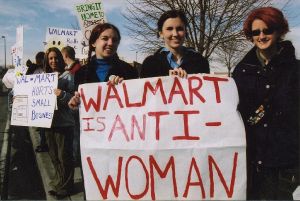
As the worldâs largest employer and a powerful economic force, Wal-Mart has gone beyond the sphere of retail competition to become a social phenomenon that many people resent and fear, and has attracted an unprecedented amount of criticism: âAmerica has a long history of controversial retailers, notes James E. Hoopes, a history professor at Babson College. "What's new about Wal-Mart is the flak it's drawn from outside the world of its competition," he says. "It's become a social phenomenon that people resent and fear.â[63]
Labor unions, Christian organizations,[65] and environmental groups[66] have criticized Wal-Mart for its policies or business practices. Several labor unions blame Wal-Mart workers' unwillingness to join their organizations on the company's anti-union stance. Other critics disapprove of Wal-Martâs extensive sourcing of products overseas, its treatment of employees and product suppliers, its environmental practices, its use of public subsidies for health insurance and child care, and the impact of stores on the local economies of towns in which they operate.[67][68]
When Wal-Mart plans new store locations, activists sometimes oppose the new store and attempt to block its construction. Opponents to new Wal-Marts cite concerns such as traffic congestion, environmental problems, public safety, absentee landlordism, bad public relations, low wages and benefits, and predatory pricing.[69]Opposition occasionally includes protest marches by competitors, activists, labor unions, and religious groups.[70][71]In some instances, activists have caused property damage to store buildings or created bomb scares.[72]Some city councils have denied permits to developers who planned to include a Wal-Mart store in their projects. Those who defend Wal-Mart cite consumer choice and the overall benefits to the economy, and object to bringing the issue into the political arena.[73]
In 2004, a Wal-Mart Superstore opened in Mexico, 1.9 miles away from the historic TeotihuacĂĄn archaeological site and Pyramid of the Moon.[74] In spite of protestors and media attention, Wal-Mart's proposal received support from Mexico's National Anthropology Institute, the United Nations, and the Paris-based International Council on Monuments and Sites.[75] Archaeologists oversaw construction and discovered a small clay and stone altar along with some other artifacts where the store's parking lot is now located.
Full-time Wal-Mart employees in the United States earn an average of $10.11 per hour,[76] potentially supplemented by quarterly bonuses of up to $1000 through the retailer's "My$hare" program.[77] Critics point out that the starting pay can be far lower, placing some employees with children below the poverty line, and that pay rates do not rise as quickly as in unionized companies. Others decry low levels of health coverage or overpriced health insurance, though the company reports that it offers rates as low as $5 per month in some areas ($9 per month nationwide) and that 92 percent of its associates are insured (though not necessarily through Wal-Mart).[78] Critics also cite Wal-Mart's high annual turnover rate of ~70 percent as an indication that workers are dissatisfied.[79]
Wal-Mart is currently facing a gender discrimination lawsuit, Dukes v. Wal-Mart Stores, Inc., which alleges that female employees were discriminated against in matters regarding pay and promotions. It is the largest civil rights class action suit in United States history. The case started in 2000, when a 54-year-old Wal-Mart worker in California named Betty Dukes filed a sex discrimination claim against her employer. In February 2007, the United States Court of Appeals for the Ninth Circuit issued a 2â1 ruling which affirmed a lower court ruling to certify the case as a class-action lawsuit; plaintiffs estimate that about 1.6 million women could be included in the suit.[80][81] According to a consultant hired by the plaintiffs[82] in 2001, Wal-Mart's EEOC filings showed that female employees made up 65 percent of Wal-Mart's hourly-paid workforce, but only 33 percent of its management. Just 35 percent of its store managers were women, compared to 57 percent at comparable retailers. The economist Marc Bendick Jr. described the ratio of female to male store managers in 2001 as below that of comparable companies in 1975. On April 3, 2007, Wal-Mart reported that female employees now made up 61 percent of its workforce and 40 percent of its management.[83]
In January 2006, Wal-Mart announced that "diversity efforts include new groups of minority, female and gay employees that meet at Wal-Mart headquarters in Bentonville to advise the company on marketing and internal promotion. There are seven Business Resource Groups: women, African-Americans, Hispanics, Asians, Native Americans, Gays and Lesbians, and a disabled group."[84]
Notes
- â "Wal-Mart Stores, Inc. (Public, NYSE:WMT)." Yahoo Finance. Retrieved November 4, 2008.
- â 2.0 2.1 2.2 Alex Beisada, Wal-Mart Stores, Inc, Hoover's. Retrieved November 4, 2008.
- â Staff Writer. "Fortune Global 500." CNN/Fortune. 2007. Retrieved November 4, 2008.
- â Wal-Mart History Retrieved November 3, 2008.
- â 5.0 5.1 Jingjing Jiang, Wal-Mart's China inventory to hit US$18b this year, China Daily. (November 29, 2004). Retrieved November 3, 2008.
- â Sam Walton and John Huey, Sam Walton: Made in America: My Story. (New York: Bantam, 1993, ISBN 0553562835).
- â Richard S. Tedlow, Sam Walton: Great From the Start Working Knowledge (July 23, 2001), Harvard Business School. Retrieved November 3, 2008.
- â T.A. Frank, A Brief History of Wal-Mart. The Washington Monthly, April 1, 2006.
- â The Rise of Wal-Mart. Frontline: Is Wal-Mart Good for America? 2004-11-16. accessdate 2008-11-03
- â Sudhanshu Ranade, "Satellite Adds Speed to Wal-Mart." The Hindu Business Line. July 17, 2005. Retrieved November 3, 2008
- â Donald Longo, "Wal-Mart Hands CEO Crown to Glass - David Glass." Discount Store News. February 15, 1988. Retrieved November 3, 2008.
- â Staff Writer. "Wal-Mart Tests Similar Hypermarkets - Hypermart USA, Wal-Mart SuperCenter." Discount Store News, March 28, 1988. Retrieved November 3, 2008.
- â Nanette Byrnes and Michael Eidam, "Toys 'R' Us: Beaten at Its Own Game." Business Week March 29, 2004. Retrieved November 3, 2008
- â Tom Buerkle, "$10 Billion Gamble in U.K. Doubles Its International Business: Wal-Mart Takes Big Leap into Europe." International Herald Tribune, June 15, 1999. Retrieved November 3, 2008.
- â John Ortiz, "Can Kroger Slow Wal-Mart?" Deseret Morning News, October 26, 2005. Retrieved November 3, 2008
- â 2007- Fortune 500." CNN/Fortune, April 16, 2007. Retrieved November 3, 2008
- â Matthew Zook and Mark Graham, with editor Stanley D. Brunn. Wal-Mart Nation: Mapping the Reach of a Retail Colossus. Wal-World: The World's Biggest Corporation in the Global Economy. (Routledge, 2006. ISBN 0415951372), 15â25
- â Wal-Mart History Retrieved November 3, 2008.
- â MCNBC October 25, 2005 Is Wal-Mart Going Green?. Retrieved November 3, 2008.
- â Robert Berner, "Can Wal-Mart Wear a White Hat?" BusinessWeek, September 22, 2005. Retrieved November 3, 2008
- â Mark Gunther, Wal-Mart sees green." CNN Money, July 27, 2006. Retrieved November 3, 2008
- â Elizabeth Souder, January 28, 2007, Will Wal-Mart Sell Electricity One Day? RedOrbit. Retrieved November 3, 2008.
- â MSNBC Wal-Mart turns attention to upscale shoppers (March 23, 2006). Retrieved November 3, 2008.
- â Caroline McCarthy, Free Shipping from Walmart.com...with Store Pickup. c|net. (March 6, 2007). Retrieved November 3, 2008.
- â "The Price Impact of Wal-Mart: An Update Through 2006" Global Insight, September 12, 2007. Retrieved November 3, 2008.
- â Brand New: Less Hyphen, More Burst for Walmart Retrieved November 3, 2008.
- â Reena Jana, July 2, 2008, Wal-Mart Gets a Facelift. Business Week accessdate 2008-07-07
- â Wal-Mart 2007 Annual Report walmartstores.com. Retrieved November 3, 2008
- â Wal-Mart 2007 Annual Report walmartstores.com. Retrieved November 3, 2008
- â Don Longo, Gasoline a Logical Extension of Wal-Mart's Reach." Convenience Store News, November 1, 2007. Retrieved November 3, 2008.
- â Wal-Mart shuttering 7-year old Bud's chain - Bud's Discount City Discount Store News, August 4, 1997. Retrieved November 3, 2008.
- â About Sam's Club. samsclub.com. Retrieved November 3, 2008.
- â "Wal-Mart.2007 Annual Report Retrieved November 3, 2008.
- â 34.0 34.1 International Operations Data Sheet - September 2008. Wal-Mart. Retrieved November 3, 2008.
- â
 PDF." Wal-Mart. Retrieved November 3, 2008.
PDF." Wal-Mart. Retrieved November 3, 2008.
- â "Company Profile." Wal-Mart Canada. Retrieved November 3, 2008
- â "Customer Services: Frequently Asked Questions." ASDA. Retrieved November 3, 2008.
- â "Wal-Mart Reports Third Quarter Sales and Earnings." Wal-Mart November 14, 2006. Retrieved November 3, 2008.
- â "Wal-Mart SEC Form 10-K." United States Securities and Exchange Commission, January 31, 2006. Retrieved November 3, 2008.
- â "Brazil Operations." Wal-Mart, October 2007. Retrieved November 3, 2008.
- â "Wal-Mart Abandons German Venture." BBC News, July 28, 2006. Retrieved November 3, 2008.
- â A. Giridharadas, S. Rai, Wal-Mart to Open Hundreds of Stores in India The New York Times, November 27, 2006. Retrieved November 3, 2008.
- â Staff Writer. "Sam's Choice Climbs Beverage Brand List - Wal-Mart's Sam's American Choice Beverage Brand." Discount Store News, October 4, 1993. Retrieved November 3, 2008
- â Sonya Reyes, August 21, 2006, Study: Wal-Mart Private Brands Are Catching On Brandweek. Retrieved November 3, 2008.
- â Emily Nelson, "Too Many ChoicesâNine Kinds of Kleenex Tissue, Eggo Waffles in 16 Flavors: Blame Brand Managers. Wall Street Journal, April 20, 2001. Retrieved November 3, 2008.
- â Barbara Mikkelson, "Code Adam." Snopes. December 31, 1998. Retrieved November 3, 2008.
- â "Wal-Mart Stores, Inc.âBoard of Directors." Wal-Mart Retrieved November 3, 2008.
- â John Stilgoe, November 23, 2003, "Wal-Mart Giant Can Be Tamed." The Boston Globe Retrieved November 3, 2008.
- â Robert Berner, May 10, 2004, "Out-Discounting the Discounter." Business Week.
- â Jack Ewing, April 11, 2005, Wal-Mart: Struggling in Germany, BusinessWeek. Retrieved November 3, 2008
- â Sang-Hun Choe, May 23, 2006, Wal-Mart Selling Stores and Leaving South Korea, The New York Times. Retrieved November 3, 2008
- â David Fairlamb, with Laura Cohn, A Bumpy Ride in Europe. BusinessWeek, October 6, 2003. Retrieved November 3, 2008.
- â Perry A. Trunick, Wal-Mart Reinvents Itself in China, Logistics Today, January, 2006. Retrieved November 3, 2008.
- â Keith Naughton, The Great Wal-Mart of China, Newsweek, October 30, 2006. Retrieved November 3, 2008.
- â Ann Zimmerman and Kris Hudson, April 17, 2006, "Managing Wal-Mart, WSJclassroom. Retrieved November 3, 2008.
- â Michael Barbaro, "Itâs Not Only about Price at Wal-Mart, New York Times, March 2, 2007. Retrieved November 3, 2008.
- â Liz Pulliam Weston, The Basics: National Bank of Wal-Mart?, MSN Money. Retrieved November 3, 2008.
- â John Zogby, Zogby: Bush Job Approvalâ34%." Zogby International, August 16, 2006. Retrieved November 3, 2008.
- â Jonathan Birchall and Holly Yeager, "A Purchase on Psephology." Financial Times August 17, 2006, 9, US edition.
- â CNBC.com Wal-Mart to Drop One-Size-Fits-All Approach. CNBC (2006).
- â Kenneth E. Stone, Impact of the Wal-Mart Phenomenon on Rural Communities, Published in Proceedings: Increased Understanding of Public Problems and Policies - 1997. (Chicago, Illinois: Farm Foundation). Iowa State University. Retrieved November 3, 2008
- â Kenneth E. Stone; Georgeanne Artz; Albert Myles, (2003) The Economic Impact of Wal-Mart Supercenters on Existing Businesses in Mississippi, Mississippi State University. Retrieved November 3, 2008.
- â 63.0 63.1 63.2 63.3 63.4 Anthony Bianco and Wendy Zellner, Is Wal-Mart Too Powerful? Business Week, October 6, 2003. Retrieved November 3, 2008.
- â Peter Breen, Industry Landscaping In-Store Marketing Institute, (March, 2006). Retrieved November 3, 2008.
- â Jeff M. Sellers, Women Against Wal-Mart, Christianity Today, April 22, 2005. Retrieved November 3, 2008.
- â Marcus Kabel, "Wal-Mart, Critics Slam Each Other on Web." Washington Post, July 18, 2006. Retrieved November 3, 2008.
- â Larry Copeland, Wal-Mart's Hired Advocate Takes Flak, USA Today (March 13, 2006). Retrieved November 3, 2008.
- â Hedrick Smith, Who Calls the Shots in the Global Economy?, PBS. Retrieved November 3, 2008.
- â Gary Washburn, H. Gregory Meyer, Wal-Mart hasn't written off city Chicago Tribune, September 1, 2004. Retrieved November 3, 2008.
- â Frank Buckley, Jamie McShane, Parija Bhatnagar, No smiles for Wal-Mart in California CNN Money April 7, 2004. Retrieved November 3, 2008.
- â Peter Shawn Taylor, February 20, 2006, Freedom to shop. National Post (Canada). Retrieved November 3, 2008.
- â Willy Rosencrans, Wal-Mart Supercenter rammed, Asheville Global Report, August 31, 2004.
- â Russell S. Sobel, Andrea M. Dean, Has Wal-Mart Buried Mom and Pop?: The Impact of Wal-Mart on Self Employment and Small Establishments in the United States, West Virginia University. Retrieved November 3, 2008.
- â James C. McKinley, Jr., No, the Conquistadors Are Not Back. It's Just Wal-Mart The New York Times, September 28, 2004. Retrieved November 3, 2008.
- â "Shoppers rush to pyramid Wal-Mart." BBC News (November 5, 2004). Retrieved November 3, 2008
- â MSNBC Wal-Mart backs hike to minimum wage U.S. Business, Associated Press, June 28, 2006. Retrieved November 3, 2008.
- â MSNBC Wal-Mart doles out bonuses to hourly staff U.S. Business, Associated Press, June 24, 2008. Retrieved November 3, 2008.
- â Wal-Mart Stores, Inc. â Benefits
- â Store Wars: When Wal-Mart Comes to Town, PBS. Retrieved November 3, 2008.
- â "Wal-Mart Faces Class-Action Lawsuit Associated Press, February 6, 2007. Retrieved November 4, 2008.
- â CNNMoney Wal-Mart to Appeal Discrimination Suit Status CNNMoney.com. (February 6, 2007). Retrieved November 4, 2008.
- â Michelle Conlin, Is Wal-Mart Hostile to Women? Business Week, July 16, 2001. Retrieved November 4, 2008.
- â April 3, 2007, Wal-Mart Stores, Inc. Recognized as Top Company for Executive Women by the National Association for Female Executives Wal-Mart Retrieved November 4, 2008.
- â Marcus Kabel,Wal-Mart CEO Expects Record Profits. Deseret News, January 5, 2006. Retrieved November 3, 2008.
ReferencesISBN links support NWE through referral fees
- Brunn, Stanley D. Wal-Mart world: the world's biggest corporation in the global economy. New York: Routledge. 2006. ISBN 0415951364
- Fishman, Charles. The Wal-Mart effect: how the world's most powerful company really worksâand how it's transforming the American economy. New York: Penguin Press. 2006. ISBN 1594200769
- Lichtenstein, N. Wal-Mart: the face of twenty-first-century capitalism. New York, New Press. 2006. ISBN 1595580352
- Walton, Sam, and John Huey. Sam Walton, made in America: my story. New York: Doubleday, 1992. 1992. ISBN 0385426151
- Vedder, Richard K., and Wendell Cox. The Wal-Mart revolution: how big-box stores benefit consumers, workers, and the economy. Washington, DC: AEI Press, 2006. ISBN 978-0844742441
External links
All links retrieved May 3, 2023.
- Official E-Commerce Website
- Official Corporate Website
- Official Public Relations Website
- Wal-Mart: The High Cost of Low Price A 2005 documentary film by director Robert Greenwald
Credits
New World Encyclopedia writers and editors rewrote and completed the Wikipedia article in accordance with New World Encyclopedia standards. This article abides by terms of the Creative Commons CC-by-sa 3.0 License (CC-by-sa), which may be used and disseminated with proper attribution. Credit is due under the terms of this license that can reference both the New World Encyclopedia contributors and the selfless volunteer contributors of the Wikimedia Foundation. To cite this article click here for a list of acceptable citing formats.The history of earlier contributions by wikipedians is accessible to researchers here:
- Wal-Mart history
- Sam_Walton history
- History_of_Wal-Mart history
- Wal-Mart_Neighborhood_Market history
- Dukes_v._Wal-Mart_Stores,_Inc. history
The history of this article since it was imported to New World Encyclopedia:
Note: Some restrictions may apply to use of individual images which are separately licensed.
